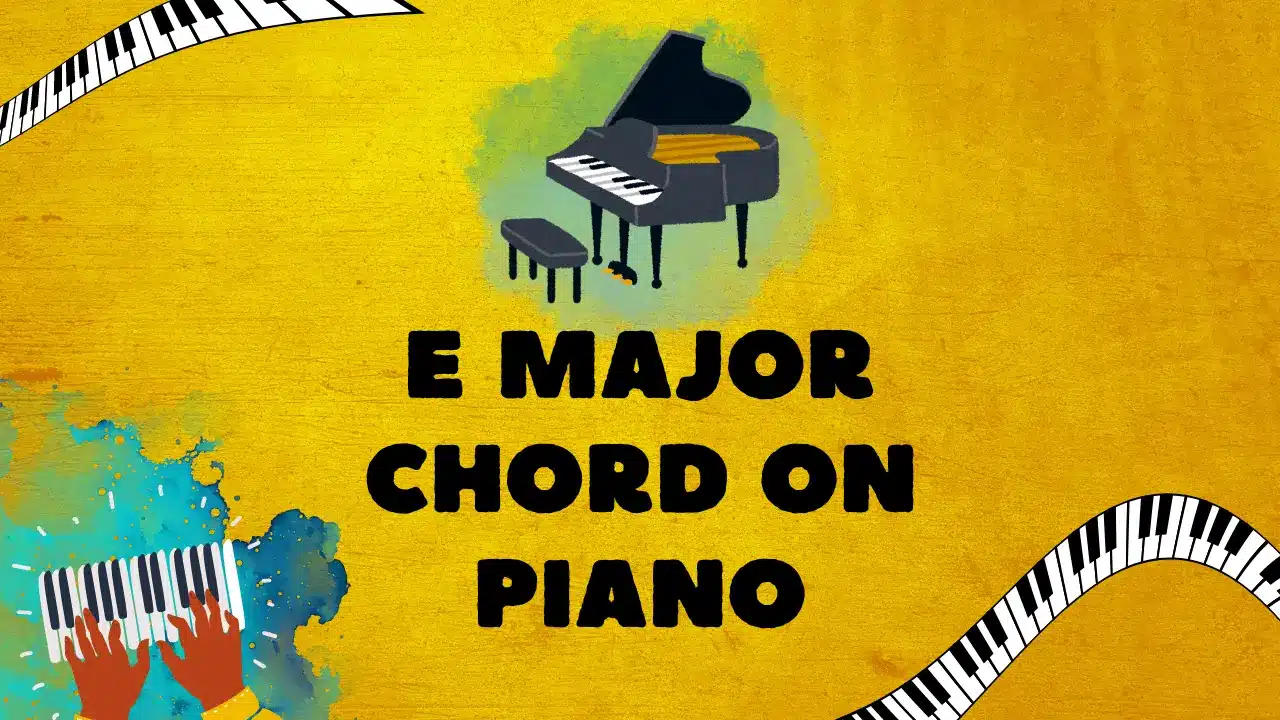- What is the E-Major chord?
- How Chords Are Built?
- The E-major scale and Its Chord Functions
- Finger Positions for the E Major Chord on Piano
- Finger Positions – How to Practice E Major Chord Piano
- E Major Chord Piano Inversions
- Why Learn Inversions?
- How to Practice E Major Chord Inversions Piano
- E Major Family Chords
- E Major Chord Progressions on Piano
- Practice Tips for the E Major Chord
- Conclusion
The E major chord on piano is one of the simplest when it comes to piano lessons. It produces a bright and happy sound, perhaps the reason why it’s very common in many upbeat music genres. However, playing the E major piano chord is not just about pressing three keys but involves knowing the interior structure of the chord, how inversions are produced, and how it can musically be used in a chord progression. In this tutorial, we are going to cover the E major chord in depth—from basic finger arrangement to related chords and important practice tips.
What is the E-Major chord?
Underneath it all, the E major chord is a triad—that is, a three-note combination of E, G#, and B—which are derived from the E major scale: E, F#, G#, A, B, C#, and D#. In order to make a major chord, we take the root, the major third, and the perfect fifth from that scale.
This combination creates a bright and consonant sound that is typical for a major chord. Here’s the breakdown of how these intervals work:
- Root: E—the note that anchors the chord.
- Major third: G#, four half-steps from E.
- Perfect fifth: B, seven half-step transpositions from E.
It’s the way these three notes relate to one another that gives the E major piano chord a some of its unique sound.
How Chords Are Built?
Major and minor chords are constructed by stacking thirds, which means with a root note you then add notes above it at either three or four half steps. For a major chord like E major:
- From E to G# is a span of four half-steps, that is, a major third.
- G# to B is three half-steps (a minor third).
These three intervals together form the major chord structure. If you understand this, then the other major chords will be much easier to learn by following the same pattern.
The E-major scale and Its Chord Functions
First, let’s take a look at the scale from which this chord is derived before diving into playing the E major chord. The E major scale on piano provides the foundation upon which the chord is built but also knowing this scale will help with knowing chord progressions and other piano chords in the key of E major.
Here are the E major scale piano notes:
- E (root)
- F# (major second)
- G# (major third)
- A (perfect fourth)
- B (perfect fifth)
- C# (major sixth)
- D# (major seventh)
That’s a very important scale, since many of the chords that are harmonically related to E major are built from these notes.
Finger Positions for the E Major Chord on Piano
The efficient playing of chords on the piano involves the proper placement of your fingers. Proper placement of the fingers will permit cord changes that are smooth, thereby allowing fluidity in your playing.
- Finger positions for the right hand:
- Thumb (1): E
- Middle finger (3): G#
- Pinky: B (5)
- Left Hand Finger Positions:
- Pinky (5): E
- Middle finger: 3: G#
- Thumb (1): B
These positions make sure your hand can be spread across the keys comfortably, in addition to the fact that you use the strongest fingers of all to play the chord.
Finger Positions – How to Practice E Major Chord Piano
It’s best to start slow, especially if you are still adjusting to playing chords. First, practice pressing each note individually before you press all three together. This way, you are making sure each note is clearly heard. In time, you should be able to press the notes simultaneously without hesitation.
For people with smaller hands, this stretch between the middle and pinky fingers can be a bit tough; with a lot of practice, though, they will become easier.
E Major Chord Piano Inversions
Chord inversions help add a great deal of variety and fluidity to your chord playing. When you invert a chord, you simply reorder its content of notes so that, although the chord sounds a little different, its core identity is preserved. Here are two inversions of the E major chord, plus the root position:
- Root Position: E – G# – B: E is the low note.
- First Inversion (G# – B – E): G# is the lowest note.
- 2nd Inversion: B – E – G#: The B is the lowest voice.
Why Learn Inversions?
You really get to take good advantage of inversions when you are switching between chords. This is because your playing inversions, instead of always always in root position, makes the movement between chords smoother and faster.
Table of E Major Inversions:
| Inversion | Notes | Right Hand Finger Positions | Left Hand Finger Positions |
| Root Position | E – G# – B | 1 – 3 – 5 | 5 – 3 – 1 |
| 1st Inversion | G# – B – E | 1 – 2 – 5 | 5 – 3 – 1 |
| 2nd Inversion | B – E – G# | 1 – 3 – 5 | 5 – 3 – 1 |
How to Practice E Major Chord Inversions Piano
Start with the E major chord in root position, then play the 1st and 2nd inversions. Create a progression—forward and backward—with these inversions. When you feel ready, practice using these inversions in your favorite songs that contain E major.
E Major Family Chords
Chords don’t exist in isolation. More often than not, they show up with their relatives in some kind of progression. E major is part of the E major family of chords—those chords created from the notes of the E major scale. Here are those chords, which often show up together in songs.
Here are the family chords of E major:
| Chord Name | Chord Notes | Chord Quality |
| E Major | E – G# – B | Major |
| F# Minor | F# – A – C# | Minor |
| G# Minor | G# – B – D# | Minor |
| A Major | A – C# – E | Major |
| B Major | B – D# – F# | Major |
| C# Minor | C# – E – G# | Minor |
| D# Diminished | D# – F# – A | Diminished |
E Major Chord Progressions on Piano
To get a better sense of the E major chord, you want to hear it in context. Chord progressions are the harmonic function of chords played simultaneously, sounding and constructing the harmony of a song. The following are some common E major chord progression on piano.
| Progression Name | Chord Progression |
| I-IV-V | E – A – B |
| I-vi-IV-V | E – C#m – A – B |
| ii-V-I | F#m – B – E |
| I-V-vi-IV | E – B – C#m – A |
Practice Tips for the E Major Chord
- Begin with A Good Posture
Sit at the piano correctly before you start to play: wrists up, fingers arched, arms relaxed. Good posture at the piano avoids fatigue, injury, and can allow your hands to play chords smoothly together. - Practice Slower
When learning a new chord, you want to take your time so as not to rush through your playing. Accuracy sounds better. Play a perfect E major chord by letting each note ring clearly. - Play E Major Songs
One of the best ways to learn a chord is to actually use one in your real music-making. Try plugging these chords into songs that use the E major chord. You will be reinforcing knowledge in a fun way. - Practice Inversions
Practice switching between root position and the inversions as you play through progressions. This will help with your technical ability but will also give you an idea about how the chord fits into a variety of harmonic contexts.
Conclusion
A common chord everyone needs to learn: major chords in E. Whether you are a player starting from scratch or an intermediate player, it is important to know the structure, the positions of the fingers, inversions, and chord family accumulated in knowledge of this chord. With minimal consistent practice, along with a few tips provided in this tutorial, you will find the E major chord is second nature to your fingers; indeed, you will master playing with confidence in any style of music. With regular practice you can easily ace this E major piano chord. But if you are struggling in any point consulting with piano experts is advisable.































